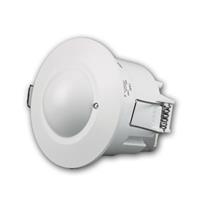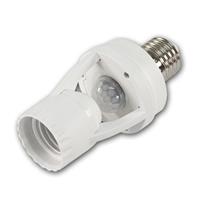Ceiling motion detector
Ceiling motion detectors offer an efficient way to automatically monitor rooms while reducing energy consumption. They are available in a variety of designs to suit different installation requirements. The most common models are recessed ceiling motion detectors, which are integrated directly into the ceiling, and surface-mounted ceiling motion detectors, which are mounted on the ceiling. Both variants offer reliable motion detection and contribute to optimizing lighting and security in residential and commercial spaces.
Recessed vs. surface-mounted ceiling motion detectors
Recessed and surface-mounted ceiling motion detectors are both excellent solutions for motion detection, but differ in their installation and practical benefits. Recessed ceiling motion detectors are integrated directly into the ceiling, offering a particularly aesthetically pleasing and unobtrusive solution. They blend seamlessly into modern interior designs and are particularly useful in new buildings or renovations, as precise installation requires exact placement in the ceiling area. Recessed detectors are also less susceptible to damage and do not take up additional space on the ceiling, making them perfect for minimalist designs. In contrast, surface-mounted ceiling motion detectors offer much simpler and more flexible installation. They are mounted directly to the ceiling and do not require any extensive modifications. These models are ideal for retrofits or rooms where adjustment of the sensor may be necessary later. Surface-mounted detectors also offer uncomplicated maintenance, as they can be accessed without major ceiling work. This makes them particularly suitable for older buildings or rooms where immediate installation is desired. Both versions offer the same powerful features, but the surface-mounted detector scores with its greater flexibility and easier installation, making it the preferred choice for many users.
Motion detector with 24GHz microwave sensor
Another notable feature of modern ceiling motion detectors is the use of 24GHz microwave sensors. This technology uses microwave radiation that passes through objects, enabling more accurate and reliable motion detection. Unlike infrared sensors, which rely on temperature changes, microwave sensors detect even the smallest movements, making them particularly suitable for large spaces or complex environments. They also respond to subtle movements, such as the movement of a person sitting or standing in a room, making them more effective than conventional motion sensors in many scenarios. An additional advantage of microwave technology is its low sensitivity to external influences. Temperature changes, humidity, or other environmental factors generally do not affect the detection of microwave sensors, ensuring their reliability in a variety of environments. These sensors are therefore particularly advantageous in rooms with fluctuating temperatures or humid conditions, such as bathrooms or basements. Microwave sensors offer an excellent solution for the reliable operation of ceiling motion detectors, even in more demanding environments.



























